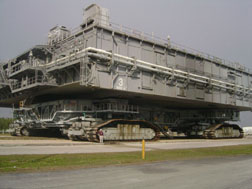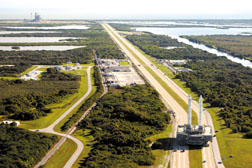NEWS RELEASES
FOR IMMEDIATE RELEASE
April 18, 2005
Sandia assists NASA with space shuttle rollout test
Project looked at massive mobile launch platform, shuttle transporter
 Tom Carne stands in front of NASA’s massive
mobile launch platform and the crawler that carries the
space shuttle from Kennedy Center’s Vehicle Assembly
building to the shuttle launch pad.
Tom Carne stands in front of NASA’s massive
mobile launch platform and the crawler that carries the
space shuttle from Kennedy Center’s Vehicle Assembly
building to the shuttle launch pad. Download 300dpi JPEG image, “tom-carne-1.jpg,” 1.1MB (Media are welcome to download/publish this image with related news stories.)
ALBUQUERQUE, N.M. — Sandia National Laboratories recently conducted a series of tests to help NASA understand the fatigue on the space shuttle caused during rollout from the Kennedy Space Center assembly building to the launch pad — a four-mile trip.
The tests are part of NASA’s return-to-flight mission, with the first flight scheduled between May 15 and June 3.
Sandia, a National Nuclear Security Administration laboratory, helped NASA design the test and instrumentation to measure the dynamic vibration environment during rollout. Sandia also computed the input forces the crawler applies to the Mobile Launch Platform (MLP). These computations are being used by Boeing and NASA to determine the fatigue life for critical shuttle components.
Sandia engineer Tom Carne assisted in a series of tests beginning in November 2003 to develop the data necessary to understand the environment and the response of the space shuttle vehicle during rollout.
“NASA requested Sandia to assist them in this project because of our expertise in planning and conducting structural dynamic tests on very large structures,” Carne says.
Sandia’s solid mechanics/structural dynamics group has done numerous structural analysis projects on large structures including the I-40 Rio Grande bridge in Albuquerque, large wind turbines up to 110 meters tall, and the Department of Energy’s Armored Tractor. One of the group’s main missions is analysis and testing of the shock and vibration environments for weapons.
The three-million-pound shuttle sits on the eight-million-pound mobile launch platform, which is carried by a six-million-pound crawler. The crawler transports the vehicle and platform four miles from the Vehicle Assembly Building to the launch pad.
Moving the shuttle that distance, which normally takes five to six hours at 0.9 mph, had been considered a relatively low-stress process during most of the life of the shuttle system. As the equipment ages, however, more emphasis is being given to understanding how the rollout may fatigue the transport system.
 The mobile launch platform and the crawler make its way to the launch pad. (Photo courtesy of NASA)
The mobile launch platform and the crawler make its way to the launch pad. (Photo courtesy of NASA) Download 300dpi JPEG image, “shuttle-crawl.jpg,” 1MB (Media are welcome to download/publish this image with related news stories.)
Data were collected for rollouts of the MLP-only and the MLP with the two solid rocket boosters, at five different speeds ranging from 0.5 to 0.9 mph. For the tests more than 100 accelerometers were placed on the MLP, crawler, and solid rocket boosters. A data acquisition system installed inside the MLP for the road test measured and recorded the accelerations. The data were analyzed so that the character of the rollout environment is understood and can be analytically imposed on the shuttle using a finite-element computer model to predict fatigue damage to critical components. Even though these stresses are much lower than those seen during the launch, the five- to six-hour duration of the transport and the low-frequency vibration could cause fatigue in components within the orbiter.
Carne says the rollout analysis team determined that there are two families of forcing harmonics caused by the crawler drive train that vibrate the platform as a function of crawler speed, in addition to the random inputs induced by the road bed. Fortunately, he says, the harmonic forcing frequencies can be adjusted by merely changing the drive speed of the crawler, resulting in less damaging frequencies.
The team used a Sandia-developed algorithm, the Sum of Weighted Accelerations Technique (SWAT), to estimate the applied forces. Carne says the SWAT results were beneficial in choosing a new rollout speed that will extend the fatigue life of the shuttle components that were affected by rollout.
The SWAT-generated input forces have subsequently been used as the force input for NASA’s NASTRAN structural analysis of the mobile launch platform, emulating the test conditions. The correlation between the rollout-measured data and the predictions from the NASTRAN analysis has engendered confidence in both the SWAT-computed forces and the NASTRAN model of the MLP and solid rocket boosters, he says.
The analyses showed that the shuttle’s vibration response can be much reduced when the driving frequencies are shifted away from the shuttle’s own resonant natural frequencies. They helped NASA determine that merely reducing crawler speed from 0.9 mph to 0.8 mph would significantly reduce the vibrations in the shuttle by shifting the impact frequency of the crawler treads.
Sandia is a multiprogram laboratory operated by Sandia Corporation, a Lockheed Martin company, for the U.S. Department of Energy"s National Nuclear Security Administration. Sandia has major R& D responsibilities in national security, energy and environmental technologies, and economic competitiveness.
Sandia media contact: Michael Padilla, mjpadil@sandia.gov, (505) 284-5325